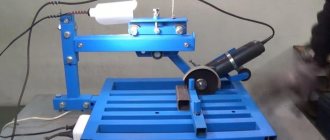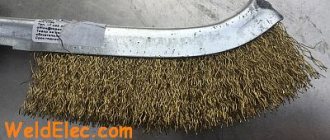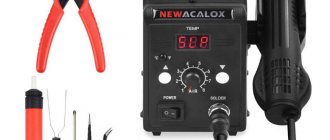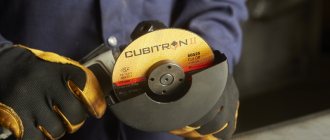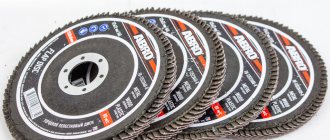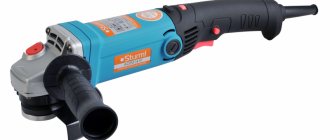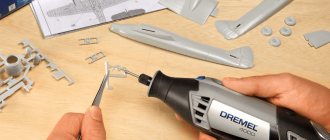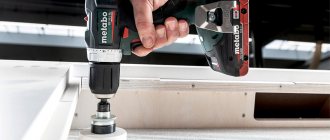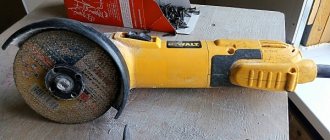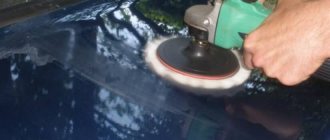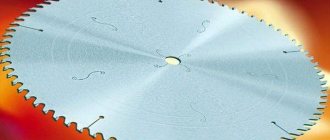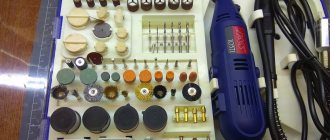Typical disk sizes for angle grinders
All interchangeable wheels have standardized sizes, so for any model of grinder you can choose a suitable size disk, even if it is “non-original” (from another company). The table below shows the typical dimensions of cutting discs in terms of thickness, diameter of the circle and seat:
| Circle diameter, mm | Thickness, mm | Mounting socket, mm |
| 115 | 1,0; 1,6; 2,0; 2,5; 3,0; 3,2 | 22,00; 22,23 |
| 125 | 0,8; 1,0; 1,25; 1,6; 2,0; 2,5; 3,0; 3,2 | 13,20; 22,23 |
| 150 | 0,8; 1,0; 1,25; 1,6; 2,0; 2,5; 3,0; 3,2 | 13,20; 22,23 |
| 180 | 1,0; 1,25; 1,6; 2,0; 2,5; 3,0; 3,2; 4,0 | 22,23; 32,00 |
| 230 | 1,6; 2,0; 2,5; 3,0; 3,2; 4,0 | 22,23; 32,00 |
The larger the diameter of the circle and its thickness, the thicker the products it can cut. Please note that the diameter of the disc should not exceed the permissible size for a particular grinder model. Thus, a 230 mm disc cannot be placed on an angle grinder with a maximum allowable wheel size of 125 mm. Such actions will force you to remove the protection, which is a violation of safety regulations, and will lead to an increase in the linear speed of the cutting edge, which is why the disk can simply fly apart during operation and injure the operator.
The diameter of the seat in most grinders is 22.23 mm, 13.20 mm is less common, and the diameter of 32.00 is relevant only for large disks. Pay attention also to the linear speed of rotation of the disk. For example, if the disc’s marking indicates a speed of 13,000 rpm, this means that your grinder must also produce such revolutions in order to work with it.
You can understand what material the nozzle can work with and what its typical dimensions are by looking at its markings on the front side. If you came to the store and picked up the disc, you can see the following:
We would like to note that sometimes the buyer may encounter non-standard nozzle sizes, and this may apply to both diameter and thickness. This often happens when purchasing “no-name” disks of unknown manufacture. We still recommend buying branded discs, since unknown ones are erased faster, and in the end you have to pay more.
Types of diamond blades
Concrete cutting can be either dry or wet, and this is closely related to the choice of blade type. Dry cutting is less labor-intensive, but it requires more durable, and therefore more expensive, discs. Wet (using water to wet the cutting area) usually requires additional labor, and the process will take longer.
When choosing the type of cutting, decide what is more important to you: saving time and labor - or money on buying disks? Once your priorities are set, you can go shopping. You will have to choose from three types of discs: segmented, solid or turbo.
In a segmented disk, the working surface is divided into sectors, which allows air to cool it better. Therefore, they overheat less and can be used “dry”. The disadvantage of such discs is a less even cut and difficulty in controlling the tool. But when cutting concrete, high precision and accuracy are rarely needed, which is why such discs are recognized as the best in this category in terms of price and quality ratio.
In a solid blade, the cutting edge is not divided into segments. It allows you to get an even and neat cut. But such a tool can only be used for wet cutting, because it overheats greatly.
The turbo disc combines the advantages of the two previous types: it copes well with dry concrete and cuts it accurately. Externally, it looks like a plate with a ribbed surface; this wave-like structure allows air to circulate, and a continuous cutting edge is maintained. But it also has its drawback: a higher price.
Please note: no matter what type of disc you choose, you cannot cut concrete for more than two minutes ! It is necessary from time to time to remove the tool from the thickness of the material and allow it to run “idle” so that the air cools the cutting edge.
Cutting discs
Cutting discs are most often used when working with an angle grinder. The following nozzles are distinguished by purpose:
- For metal. Such cutting wheels are made from electrocorundum or crystalline corundum. In this case, a bakelite bond is often used inside the product. Depending on the thickness and size, the disc can cut metal profiles, stainless steel, heating pipes, etc. GRAFF GADM 115 10 is one of the representatives of inexpensive metal discs.
- For stone and concrete. Circles for cutting stone and concrete are made of silicon carbide. Please note that the disc is intended for relatively “soft” materials, such as white brick and slate (harder ones will require a diamond wheel).
- For ceramic tiles and concrete. This attachment is designed for cutting paving stones, ceramic tiles, red bricks, cutting strips for gating, etc. The disc itself is made of metal with diamond chips applied to the cutting edge. There are solid all-metal and segmented discs. The first ones are intended for wet cutting (cooling with water), as they become very hot during the process. Segmented ones are convenient for dry cutting, and they are the most popular among diamond blades. Here, for example, is a high-quality, durable segmented disk Makita B-28086 for cutting concrete and stone products.
- For wood . Discs for processing wooden structures are made of tungsten carbide or metal with abrasive coating. The first ones are designed for cutting hard and soft wood, plasterboard, gas silicate and MDF. The second one can also cut metal and even wood with nails (but this needs to be checked experimentally). Bison Professional 36859-125 is just such a representative of the “nail saw”.
- Universal. These attachments can cut almost all types of materials (for wood, it is better to take a direct-use attachment). In particular, they are convenient to use when you have to cut different materials in one working day, and you don’t want to waste time changing the nozzle. Universal models even cut reinforced concrete. However, they are often quite expensive, and sometimes it is more profitable to buy two disks for different types of materials being processed. Of the good universal circles, we can recommend Wolverine 100125, which is suitable for both wet and dry cutting.
Features of application
After purchasing diamond or other discs for an angle grinder, it is important to familiarize yourself with the list of materials for which they are intended. In order not to forget what materials they are intended for, it is recommended to save the packaging until the products are disposed of.
It is necessary to install the product into the tool using a special fixing key. If, after installing the wheel in the seat of the angle grinder, it begins to rub against the cover, then it is prohibited to start the device. Various types of work with angle grinders should be carried out using protective equipment: goggles, a respirator or mask, gloves and special clothing.
It is important to pay attention! When working with an angle grinder, the tool should be held with both hands, as strong vibrations occur during its operation.
When cutting granite or concrete, it is recommended to use the wet method. This will not only eliminate the occurrence of dust, but will also allow the cutting disc to cool during operation. Both methods can be used to cut stone, marble or ceramics.
Roughing
It’s worth mentioning right away that roughing and grinding discs go hand in hand, and in many stores in the “type” parameter of the attachment it may be written: “roughing grinding disc.” In our article we will divide this “couple” into two types. Peelers in this context are an attachment for freeing the structure being processed from the outer layer, for example, from rust. There are the following peeling attachments:
- Cord brushes. Cord brushes are disc or cup-shaped. Disc ones are convenient for cleaning vertical structures, for example, a tubular fence, and cup-shaped ones are used for cleaning horizontal surfaces. So cord brushes are very convenient for cleaning a car body after welding or removing rust. Here is an average-priced brass cord brush STAYER 35125-150:
- Roughing discs. Sanding discs, like cord brushes, can be flat or cup-shaped. They are intended for cleaning welds and preparing metal surfaces for grinding.
Scope and properties of diamond segment disc
Diamond segmental blades are used when cutting high-strength materials, these include: concrete, masonry, bricks. They are used only for dry cutting. Thanks to the segmented shape, cooling and removal of dust remaining after cutting is carried out. The more segments there are on the disk, the faster it will cut the material. While conventional discs fail very quickly, diamond ones do not lose cutting depth and maintain the diameter of the disc, due to this they justify their high cost. And if used correctly, they can even help you save money.
Reasons for decreased cutting quality
There are times when a diamond disc stops cutting the material; in order to return it to working form, it is recommended to cut off the abrasive layer until diamonds appear. Also in such cases, it is worth paying attention to the correspondence of the disc markings to the material being cut. The service life of a diamond blade largely depends on what materials it will cut. Accordingly, with low-density materials, the disc wears out less than when cutting high-grade concrete. Long periods of continuous operation and overheating can lead to a crack in the disk, and subsequently to its failure.
Grinding
Grinding wheels are used for polishing concrete, metal and wooden surfaces for painting or priming. Attachments for circles can be made of sandpaper, felt and even felt. In turn, the design of sanding wheels can be petal or flat (put on a wheel).
Each grinding disc has its own grit size. It is selected depending on the work being performed. Below is a table for selecting wheel grit depending on the type of grinding:
| Types of grinding | Recommended grit number |
| Flat | 16 — 36 |
| Round roughing | 24 — 36 |
| Round finishing | 60 — 100 |
| Finishing a multi-blade tool | 170 — 220 |
| Finishing | 180 — 320 |
| Thread grinding | 100 — 280 |
Disc marking by color and size
It is worth noting that the discs differ from each other in the color of the front side and this is no coincidence. The different colors on the discs are markings indicating what kind of work they can do, for example:
- discs marked in yellow are intended for working with tiles or plaster;
- green is used for concrete or granite;
- orange discs are used for working with brick or plaster;
- gray discs are used for cutting ceramic tiles
Depending on the manufacturer, color markings may vary slightly.
The discs also differ in diameter. The depth of cut depends on the diameter of the disk; the larger it is, the deeper the material will be cut, but as the diameter increases, the rotation speed will decrease. Another aspect of a larger blade diameter is increased service life, since the larger the diameter, the less pressure is applied to each diamond. The maximum value of the circle diameter must necessarily correspond to the capabilities of the tool. Violation of this requirement can damage not only the disk, but also the instrument itself.
Today, manufacturers produce discs with the following diameters:
- 115 mm;
- 125 mm;
- 150 mm;
- 180 mm;
- 200 mm;
- 230 mm.
The most popular among owners of grinders are discs with a diameter of 230 and 125 mm. For use on an industrial scale, discs of increased diameter are produced; as a rule, the machines on which they are installed are highly powerful and belong to the professional class, called cutting machines or seam cutters.
To summarize: how to choose a disc for an angle grinder?
To properly buy a disc for an angle grinder, you need to:
- Know the maximum size of disks that your angle grinder can handle. You cannot take disks larger than the device allows.
- Know the maximum speed of the grinder . The higher the rotation speed of the angle grinder, the smaller the disk size it can work with.
- Processed material . There are discs for wood, metal and stone. There are universal ones that can cut almost anything.
- Socket size . The size of the wheel seat must correspond to the same parameter in the angle grinder.
- Manufacturer . Do not buy frankly cheap discs or unknown products like hot cakes in the school cafeteria, and the savings will be minimal.
